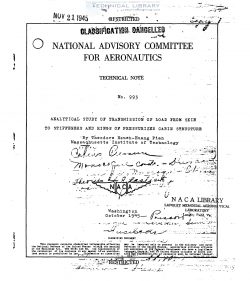naca-tn-993
- Version
- 173 Downloads
- 1.57 MB File Size
- 1 File Count
- December 2, 2016 Create Date
- December 2, 2016 Last Updated
National Advisory Committee for Aeronautics, Technical Notes - Analytical Study of Transmission of Load from Skin to Stiffeners and Rings of Pressurized Cabin Structure

The general problem of this paper is the defermation
and-the stress analysis of-a pressurized cabin_struqture.
consisting of sheet metal skin, longitudinal stringers. and g
a finite number of rings which are equally_spaced between
two end bulkheads. The minimum potential energy-method is
used. The deformations are calculated by eolving_the simul-
taneous difference equations, involving three deformation
parameters - radial expansion of rings, quilting of stringers.
and transverse elongation of skin. The tensile-stresses of
the rings and the stringers. and the longitudina1_and the L”
circumferential stresses of the skin are determined from the
deformations. A few special cases from the general problem .
are also considered. ,~~ _. ,:<
The results obtained during tests of pressurized cabin
structures by both the Lockheed Aircraft Corporation and_the
Consolidated-Vultee Aircraft Corporation yield reasonable ;
checks with the results from the theoretical analysis.
The requirements of comfort during a high altitude
bombing mission, and in the commercial passenger airplane.
call for a new design trend of airplane structure, the pres--
surized cabin structure. 1' . -" - -
*Thesis submitted in'partial fulfillment of the require-
ments for the degree of Master of Science from Massachusetts
Institute of Technology, 1944.
A series of laboratbry'ihvestigations (reference 1)
were carried out at Wright Field during 1935 and 1936, on
pressure cabins, the results of which formed the basis of
the specifications of the first practi_cal substratosphere
airplane, the Air Corps Model (Lockheed) X0~ 35. The results
show also that the simplest and lightest type of structure
is a round cylindrical vessel with hemispherical heads. and
that the present standard design of semimonochue construc—
tion of fuselage is- quite suitable. The first passenger
airplane with pressurised cabin, the Boeing 307-B "Strato—
liner" (reference 2); he of the same type of all-metal
structure as the Lockheed, circular in section, with alumi-
num—alloy rings. partition bulkheads.
| File | Action |
|---|---|
| naca-tn-993 Analytical Study of Transmission of Load from Skin to Stiffeners and Rings of Pressurized Cabin Structure.pdf | Download |
Comment On This Post